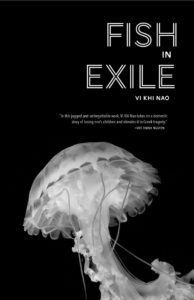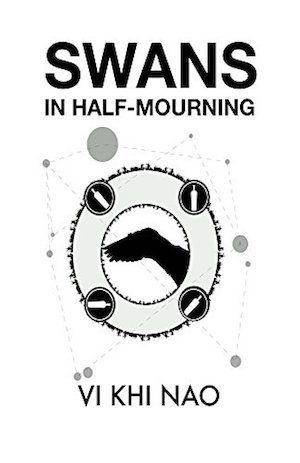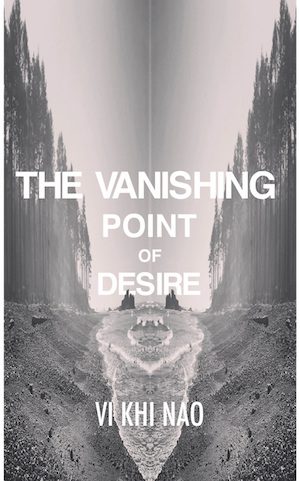
Of the many things we are taught as young children, the ability to navigate grief is often overlooked. It’s something more learned through experience, a quality that we may indirectly witness others encountering but will not truly understand until we are at its center.
Through a spiraling web of characters and myths, author Vi Khi Nao explores the secondary and direct effects of unexpected loss in her novel Fish in Exile (Coffee House Press, 2016). In this elegantly melancholic tale, Nao explores the unexpected and insurmountable death of the Romulus children through the people who knew them best: their parents, neighbors, and extended family. Nao calls to Greek and Roman mythology in both form and content while gracefully examining survivor’s grief, the fallout of split-second decisions, and the gray space of recovery.
Fish in Exile melts traditional academic narrative with magic and folklore, creating an unforgettable story that reminds the reader there is no universally correct approach to dealing with grief.
***
The Rumpus: The language in Fish in Exile flirts with the past through its formality and length, but there are contemporary markers like iPhones and Toyotas that bring us into the present day. Did you face any challenges in moving between the ancient and present day?
Vi Khi Nao: No, it was all one finite landscape for me. When some modern concept comes up, I have no issues with using it at any given moment. It’s also a nod to my novella Swans in Half-Mourning, which is a remaking of The Six Swans from a Sapphic perspective. The characters move from half-bird form to human flesh, so with Fish in Exile I was able to move from one time to another seamlessly. For some readers, this might take them out. It’s part of the texture, though. We go to a museum and see the Mona Lisa, but we also have our iPhones! It’s where we’re living now in this moment in time, like taking selfies in front of ancient art. So when Hades and the iPhone both show up, I think it would say more about our collective social consciousness if something like that didn’t happen in my book. I would be countering our current time, which simultaneously embraces the past, present, and future.
Rumpus: Writers are often told to study works of the past, with the goal of not only being aware of what’s been done but also to find their own voice. And while some might only delve into the most recent centuries past, you bring readers all the way back to the power of Greek and Roman mythology. Were you familiar with these myths before the conception of Fish in Exile, or did you research as you wrote?
Nao: My first language was Vietnamese and my second was Latin, and I had a tutor who had training in Greek and Roman mythologies. When she taught me English, she said the best way to learn was through Latin. So during my Latin lessons, she would read me all these Roman and Greek mythologies, and they’ve influenced me since I was about twelve years old. I didn’t have to do a lot of research for Fish in Exile because they stayed with me.

Nao: I mapped out a preliminary blueprint of the social conditions in the characters’ homes and the intimate interactions within. Ethos, despite his masculinity, is quite susceptible to emotions. His name has a fluid structure, while his wife Catholic is very rigid in form. She’s also able to contain a lot, and she reminds me of a caryatid. They’re the women who hold up the pillars of ancient Greek architectures. She has that structure to her character and she’s very grounded in reality, as well as in her grief. She doesn’t allow herself to go to the emotional places that her husband does.
Rumpus: In addition to Catholic and Ethos, you have a string of well-developed secondary characters, including neighbors, family members, and even a young boy. Through them, we’re able to see more of how grief manifests alongside blame, healing, and progress. Where did you envision the minor characters working either with or against your protagonists?
Nao: Because Catholic and Ethos lead a very private life, their primary social interaction is with their neighbors. It’s a formed community and there’s something desolate about them. The broader community just can’t relate to the parents’ grief. When Catholic interacts with Callisto, it’s the first form of communication about her grief. It’s her extending emotion from beyond her body and the architecture of the house. The neighbors are necessary because otherwise the grief has no place to move. Even the little boy who visits them, despite his young form, has a tremendous impact through his interactions with the grief of the Romulus family. In that sense, I felt like there was a balancing act between the protagonists and their neighbors. They’re the shadows that lead into answering the particularly difficult questions about what really happened to the children. Without the neighbors, there’s no light.
Rumpus: There’s a tremendous amount of solitude and inner questioning from this melancholic cast, though they do reunite physically through conversation and social engagements. How did you find that the presence and absence of interaction changed as you wrote?
Nao: I wrote many of the pieces in sections and completed an early draft on a typewriter, so the characters were on the page but lacking their emotional form. It took me several years after moving around the country and shifting landscapes for the flow of emotional water to arrive between the characters. All of the characters on my typewriter were like a pre-inflated balloon. They were rubbery and they stretched, and I could see the possibility of gaining air. It wasn’t until I landed in Providence for my first year in the MFA program at Brown University that the characters slowly started to inflate.
Rumpus: At what point in writing do you let your characters take responsibility for their actions, rather than deciding what’s to come in regard to their fate?
Nao: I’ve felt like I really have no choice in the way the characters evolve. When I sit down to write, the voices come very passionately and very fast. I don’t have to agonize over one word, it just comes. For a while, I actually didn’t want the marriage between Ethos and Catholic to work out. It was designed to split, but their relationship turned out to be less like a candle and more like a kerosene lamp. Ethos’s voice became so passionate and his commitment to his wife was so strong that as a writer I had no voice in it. He took over and he told me what was going to happen between him and Catholic, and I just had to sit down and watch it unfold.
Rumpus: Do your characters ever surprise you, either with what they have to tell you or how they choose to act the longer you get to know them?
Nao: Yes, I didn’t expect several scenes here to happen. I didn’t think there was going to be a little boy coming into the narration, I thought everyone was going to be an adult and that there wouldn’t be a single child. There’s a god-like wisdom about youth, and the small boy is almost like the voice of God. He gives them light when they don’t expect it at all. I wanted the absence of children to be so dominating and domineering, so that it would fill up the page with so much sorrow that the possibility of there being more children would be too great and too terrifying. But he comes in and the things that come out of his mouth surprise me. I like his dialogue a lot and I liked getting to know him, even if it was very short and brief.
Rumpus: In regard to the treatment of her husband, you write that Catholic has seen “women apologizing for behaving the way they do.” Why did you feel it necessary to have her not only call out this repentant phenomenon, but to have her follow suit and apologize to her husband for her actions against him?
Nao: As women, we tend to apologize for everything. We do it in important moments and also in non-important ones where what we’ve done hasn’t actually rubbed anyone the wrong way. Women in our culture are forced by a larger social consciousness to over-apologize, and so even when we should apologize I don’t think we really should. Not because it’s not a question of one needing to apologize, but a question of the absence of being silent with the air. If we allow women to be in silence during those times in which we make an error, or whether we do something that’s sinful, the silence can be the apology. Catholic doesn’t apologize for who she is, and I think of all my characters that she’s my favorite. When I get other people’s feedback on the book, they’re often huge fans of Ethos. But my greatest love is for Catholic because she endures tremendous guilt. She shouldn’t have to apologize for making a choice that violates her sense of self.
Rumpus: Why did you decide to build until the final section to give us the perspective of Catholic, who as the mother of not one but two dead children, appears to be most directly affected by this tragedy?
Nao: I began with Ethos because he’s the character you can most sympathize with, and from him I move into different levels of focal points. Catholic isn’t always able to communicate how she feels or why she behaves a certain way. I wanted to build up to a moment where a lot of people might judge her for her infidelity, her coldness, or her lack of communication, and see that it’s the result of her sacrifices. When you have a difficult choice to make, you don’t always have five hours to think about it. I want readers to be able to care for her the most. Originally I had written this like a detective novel so that the reader would work to find out what happened to the husband and wife, but also to the children. I wanted it to be an exploration of the journey these characters take. Why is the husband behaving so neurotically? Why is the wife so cold and distant? You can look at these characters from the outside and from there it’s so easy to digest them. I want people to have compassion toward these characters that we can’t seem to understand or be able to really see into their internalization. I want readers who look at people from the outside not to judge them based on their appearances or outward behaviors.
Rumpus: Within the story lies an unmistakable playfulness that brings air to the darker moments, like the act of taking a fish for a walk in the ocean while looking for a drowned child. How do you balance and separate the lighter and heavier happenings without devaluing them?
Nao: When you’re that heavy with your own grief, the pressure of sadness can be too much. Just like a balloon, it can pop. It reminds me of how stand-up comedians crack a lot of jokes but can be some of the saddest people. Because the entire book is filled with a tremendous sadness, the humor exists almost as a result to that imaginary balloon popping. It has to have an outlet, and humor is that outlet.
Rumpus: Where do you think comedy and humor can be used in fiction to add depth and believability?
Nao: One should experiment with that, since not all humor works. There was a scene I did that was omitted from the manuscript that dealt with beehives, but just didn’t work. Humor is one of those things that can’t be made to order. It’s like information, you can’t force it but you can stimulate it to become something else. A reoccurring scene in which certain moments repeat themselves might help add to the layering of humor. I also like it when comedy builds upon itself and becomes a ventilation system for a manuscript.
Rumpus: In the initial drafting phase, did you find more that plot-matter affected the novel’s form or inversely that form changed the narrative arc? Did that change as the narrative grew?
Nao: It’s really difficult to be able to discern. Typically, I write smaller stories or flash fiction with an emotion in mind, so a person will feel really sad or creative or very bored or really sexual. Those are the driving forces behind that form. With Fish in Exile, I had a plot in mind but I didn’t want things to happen without cause. I sat down and wrote a blueprint of what was going to happen, how it was going to happen, and when it was going to happen. It was also very experimental, so the balance between experimentalism and the high level of methodic plotting worked really well. I’ll sometimes speak with a playwright about how difficult it is to write plays, because people think you can just slap a bunch of scenes together and call it a play. But plays are driven by a particular method, so when I use a play form I want to write in a rhythmic style. It helps me heighten the plot and make it more intricate. There’s another layer of dimension, intellectually and emotionally.
Rumpus: The use of footnotes lends a more academic feel to the text, and it calls out attention to details that support without changing the narrative. Why did you decide to use these?
Nao: I really love them and I tried to add a bunch more, but we had to remove them because they didn’t fit. I love academia and learning, and you really only see footnotes in academic works. I like them in fiction because I want to learn something about a work and I don’t want it to be attached to the primary page. It’s sort of like choosing your own road when you read. That road can go to many places and you have the choice whether or not you want to take it.
Rumpus: Do you hope that more authors will begin to manipulate form in their writing?
Nao: Yes. There’s a meta component to using different forms that reminds readers they’re engaging with a piece fiction. It uses life and things that people do experience, but it’s also a piece of art. We shouldn’t get into fistfights over scenes, we should marvel over them. They’re designed to generate human peacemaking, not to instigate wars.
Rumpus: Similar to the form of this book, you’re a bit of a renaissance woman when it comes to working across creative genres. How does working in one mode of art affect your work in another?
Nao: I get passionate with everything I do, and I love moving through different gates. The way I travel is important, because one day I’m in New York and the next day I’m in Las Vegas. As writers and thinkers, the shifting landscape is a natural habitat. And in terms of form, this is actually the least experimental. With fiction, you can see a novel take shape. My other manuscript doesn’t look like a novel. It has so much going on with it that the pages naturally shift. You don’t know if you’re reading a poetry manuscript or a piece of fiction, or maybe even a diagram.
Rumpus: There’s not a single word choice or variation in form that feels out of place here, and that undoubtedly comes from both a careful authorial eye and a sharp but open editor. Can you talk a little about your relationship with your editor at Coffee House Press?
Nao: I loved working with Lizzie Davis. She’s an amazing editor and I was very fortunate to have her because I don’t have a lot of attachment to my work, in a sense that it doesn’t bother me if an editor wants to make drastic revision to the manuscript. Lizzie has a very intelligent, keen eye. She was able to remove a lot of the excess, which helped elevate the manuscript to another level as a result of her acuity for language and plot. She’s also very thorough and she read the manuscript several times. Each time, she was able to see something that would make it even better. I’m actually dyslexic, and it didn’t originally occur to me how much my dyslexia confused her, but she was very patient in reviewing it. There’s a maturity to the way she edits that can’t be learned, it’s an intrinsic or natural talent. Sometimes you have to experience things before you can gain knowledge, but I don’t think that’s the case here.
Rumpus: How did Fish in Exile change throughout the editing process?
Nao: There was a lot of repetition in my work and I had made a point to make it purposefully that way. If a character does one thing, he’s always going to do it again. It’s an emotional device that they use to cope with their grief. I wanted that to happen more in my manuscript, but the editors brought to my attention that I didn’t have to worry about having excess to have the plot remain strong. Several scenes were also shortened so that the reader is still be able to get the point without the characters perseverating.
Rumpus: One’s healing following an event of great trauma can only be determined by that particular person, and the same can be true of most fictional characters. But within a novel or short story, there are limits to what can happen both to affect and resolve a catastrophe. Craft-wise, do you have any means of predetermining the evolution and rate of healing for your characters as you write?
Nao: When I wrote Fish in Exile, I knew I had to show that things would change for my characters. I just didn’t know at what speed it would happen. It took me three years to write this and my rate of change couldn’t exceed what the characters were capable of. In many ways, I feel like I had no control over the time in which they grieve. Knowing that helped release the burden of wanting to finish it at a certain time, and I remember the moment when I did finally realize I was done. I had so many drafts of the ending and it changed so many times that it took me a year to write just that final part. I had to wait until the manuscript gave me permission to be what it is now.
Rumpus: You pose a somewhat magical but also highly philosophical question halfway through your novel: “Can freedom exist for a fish?” Whether the fish is within a bowl or within the ocean, there’s always going to be some sort of confinement. And that’s what your characters experience in their lives post-children, where they can’t escape their grief because it’s confined not only in their home within their own bodies. Do you think it’s possible to exist both within the world while in avoidance from it?
Nao: In order to have freedom, we need to have constraint. Not just any constraint, but the right one for each of us personally. It reminds me of a phrase I often use: a bird is chained to air. There’s a prison in the air for a bird, but they need to have that dual existence in order to survive. The best writing I’ve done has a healthy dose of constraint, some sort of parameter by which I could know where my limits are. Not having limits is dangerous and can be ineffective, whether it’s the sea or the home or emotional constrictions. I think because Catholic gives Ethos constraints, his love for her just grows and grows. She loves him but she’s afraid to be close to him because that same closeness created catastrophe. Her responses to him are visceral and tidal. Some people might view that as a form of control of imprisonment, but at the same time while it’s definitely that, it’s also replenishing act of creativity. As creators, we need to have that reinforcement. It’s the duality between freedom and imprisonment, between coldness and tenderness. We need those binaries in order for something to have that beautiful chemistry and tension through transformation.
***
Author photograph © Frank D. Hunt.








